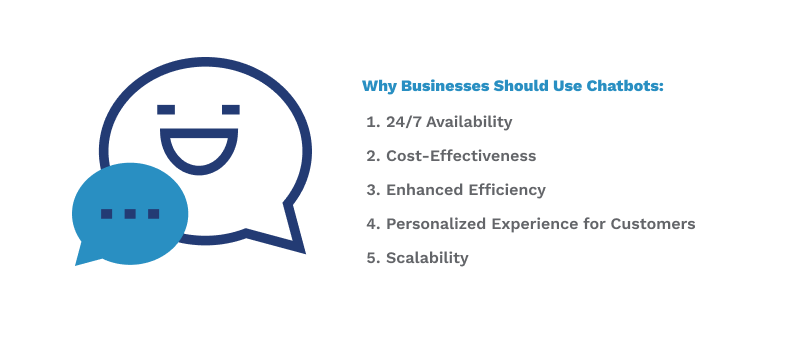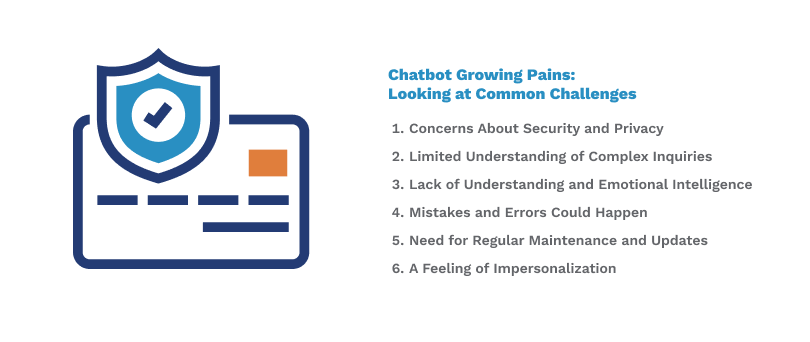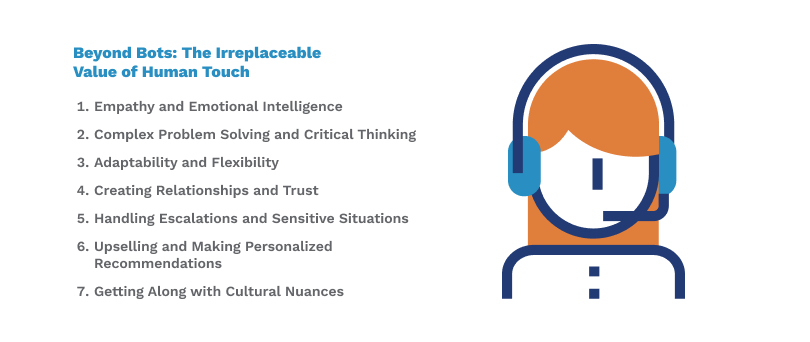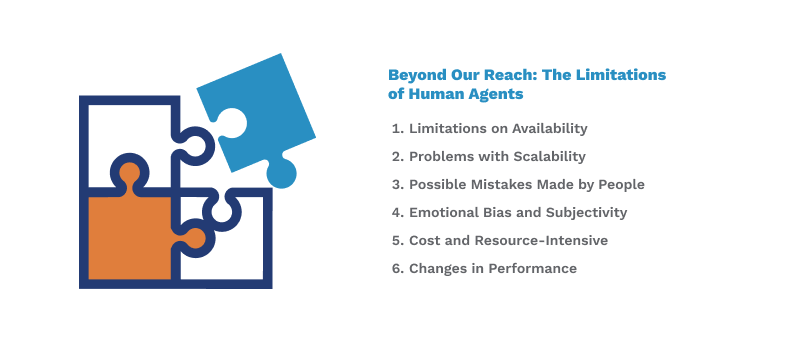Customer service has changed a lot with the rise of digital communication and artificial intelligence (AI). Companies are now looking for more efficient, scalable, and cost-effective ways to improve customer experience. This has led to two popular approaches: chatbots vs. human agents for customer service. Both have their strengths, and businesses need to understand how each can play a role in their customer service strategy.
At Big Outsource, we offer an unbiased look at both options and show how outsourcing customer service can be used to help your business grow and stay ahead.
Beyond Human: How Chatbots Supercharge Your Service
Chatbots have quickly become an important part of providing modern chat support and customer service. They have changed the way companies talk to their customers. AI and machine learning power these technologies, so they can answer simple questions automatically and work virtually non-stop.
Because of this, they offer many benefits that help businesses that want to streamline their processes, handle a lot of customer contacts, and lower their operational costs.
Chatbots are good for both businesses and users in many ways:
Why Businesses Should Use Chatbots:

- 24/7 Availability: Because chatbots offer customer service 24 hours a day, 7 days a week, customers can get help at any time, regardless of work hours or time zones.
- Cost-Effectiveness: Because chatbots can answer a lot of questions at once, they cut down on the need for human workers and customer service costs by a large amount.
- Enhanced Efficiency: Chatbots take over boring jobs like answering frequently asked questions, updating customers on the status of their orders, or gathering feedback from customers. This frees up human workers to work on more difficult problems that need a human touch.
- Personalized Experience for Customers: Chatbots can use AI and data about customers to give them customized answers and suggestions depending on the target audience. This makes conversations more relevant and interesting for customers.
- Scalability: Chatbots can quickly grow to handle more interactions with customers, so they can keep things running smoothly during busy times without lowering the quality of service.
Benefits for Customers:

- Instant Responses: When a customer asks a question, a chatbot can answer right away, cutting down on wait times and making the whole experience better for the customer.
- Convenience: Customers can talk to chatbots through the methods they prefer like websites, messaging apps, or social media sites. This gives them freedom and easy access.
- Self-Service Options: Chatbots give customers the power to find information and solve problems on their own, which makes them less dependent on human workers and more independent.
- Proactive Support: Chatbots can start conversations and help customers before they even know they need it by guessing what they need and giving them answers.
Chatbot Growing Pains: Looking at Common Challenges
Chatbots can help with customer service in many ways, but they also have some issues that users and companies should be aware of:

Concerns About Security and Privacy: Like any other IT service, chatbots can have security holes or privacy invasions. Companies must take the right steps to keep customer information safe and make sure that conversations with chatbots are private and safe.s ready to explore the advantages of CRM outsourcing, Big Outsource is here to help. Our experience and dedication to client success make us the ideal partner for improving your CRM management.
Limited Understanding of Complex Inquiries: Chatbots are great at answering simple, regular questions, but they don’t fully understand complex ones. But they might have trouble understanding sarcasm, complicated problems that need human reasoning and problem-solving skills, or language with a lot of nuance. For customers who need more in-depth help, this can make them frustrated.
Lack of Understanding and Emotional Intelligence: Chatbots are getting smarter, but they still can’t fully understand and connect with people on an emotional level. One problem is that they might not be able to understand and help customers as well as a real person, especially when customers are upset or frustrated.
Mistakes and Errors Could Happen: Because chatbots use pre-programmed answers and algorithms, mistakes and misunderstandings can happen from time to time. If they aren’t properly taught or kept up to date, they could give wrong information or not meet the customer’s specific needs, which would slow down the resolution process.
Need for Regular Maintenance and Updates: Chatbots need to be maintained and updated on a regular basis to make sure they work right and give correct information. This can include teaching people about new goods or services, dealing with changes to rules or procedures, and adapting to what customers want as they change.
A Feeling of Impersonalization: Some customers might think that talking to a robot is cold and lacks the human touch that is important for building strong relationships with customers. People may think that a company is less approachable or cares less about its customers if it relies too much on chatbots.
Beyond Bots: The Irreplaceable Value of Human Touch
In terms of customer service, real people are still better than robots in a few ways that make them a necessity:

- Empathy and Emotional Intelligence: People are great at reading and responding to the feelings of others, showing empathy, and making friends. Being able to connect with customers on a personal level builds trust and loyalty, especially when dealing with difficult or sensitive problems that could make customers feel frustrated or exposed.
- Complex Problem Solving and Critical Thinking: Human agents can use their knowledge and critical thinking skills to solve complicated problems that a chatbot’s programming might not be able to handle. They can look at things from different points of view, come up with creative ideas, and change how they do things based on what the customer wants and needs.
- Adaptability and Flexibility: Human agents are naturally flexible and can easily handle tasks or situations that come up out of the blue. They can pick up on subtleties in language, read body language, and change the way they talk to each customer to fit their needs. This flexibility lets exchanges be more tailored to each person and work better.
- Creating Relationships and Trust: Talking to people in person lets you build real relationships with them, which builds trust and loyalty over time. Customers often like the personal touch and care that a real person can give them, which makes them happier and more likely to buy from you again.
- Handling Escalations and Sensitive Situations: Human agents can calm down customers who are angry or upset, show sympathy, and reassure them. They know how to handle tough conversations with tact and diplomacy, finding solutions that make customers feel heard and respected.
- Upselling and Making Personalized Recommendations: Human agents can use what they know about a product or service to make personalized suggestions and find upselling changes based on what the customer wants and needs. This personalized method can make things better for the customer and boost sales.
- Getting Along with Cultural Nuances: Human agents can better understand and deal with cultural nuances in conversation, making sure they treat customers from different backgrounds with respect and do a good job. Being aware of ethnic differences like this makes everyone feel welcome and improves customer satisfaction.
Beyond Our Reach: The Limitations of Human Agents
Human workers have some unique strengths when it comes to customer service, but they also have some weaknesses when compared to chatbots:

- Limitations on Availability: Human workers are limited by their work hours, breaks, and shifts. Response times may be slowed down by this, especially after work hours or during busy times. Chatbots, on the other hand, are available 24 hours a day, seven days a week, so buyers can always get help.
- Problems with Scalability: Adding more human workers to a team to handle more customers can be expensive and take a lot of time. Chatbots, on the other hand, can easily handle multiple chats at once, so even during busy times, service quality stays the same.
- Possible Mistakes Made by People: Because people aren’t perfect, human workers can make mistakes or get customer questions wrong. Making mistakes that hurt the customer experience can happen because of being tired, distracted, or not having enough training. Even though chatbots can make mistakes, they are usually better at giving correct information because that’s how they were programmed.
- Emotional Bias and Subjectivity: Even if a human agent is kind and caring, they may be affected by their own feelings or personal biases, which can change how they deal with customers without meaning to. Because chatbots don’t have feelings, they can solve problems more logically and consistently.
- Cost and Resource-Intensive: It can be very expensive for companies to hire, train, and manage a team of human agents. Once they are built and put into use, chatbots don’t need as much ongoing funding and can be a cheaper way to answer common customer questions.
- Changes in Performance: Human actors may show changes in performance even after being trained because of their skills, knowledge, and experience. In comparison, chatbots provide a more uniform and steady level of service because of the data they use to program and train themselves.
Chatbots and human workers will likely work together to provide seamless client experiences in the future. Human agents add empathy, creativity, and problem-solving skills, while chatbots offer efficiency, scalability, and 24/7 availability. Businesses may meet many client requests while optimizing resources and retaining satisfaction by combining both solutions into their customer service strategies.
Technology will blur the line between chatbots and humans. In situations requiring emotional intelligence, creativity, and relationship-building, the human touch is crucial. Businesses that can blend automation and human engagement will lead to customer service in the future.
How Outsourcing Services Leverage Both Chatbots and Human Agents
There are a few ways that outsourcing can find a mix between chatbots and real people, using the best parts of both to give the best customer service:

Leveled Support System
Chatbots handle Level 1 support. Chatbots are great for handling first encounters, giving quick answers to frequently asked questions (FAQs), walking users through basic troubleshooting steps, and gathering basic information. This frees up human workers to work on more difficult problems.
People handle Level 2 and Level 3 support: When problems get too big for the chatbot to handle, the conversation is smoothly passed to a real person. This makes sure that each customer gets the help they need, even when they have complicated questions or are dealing with a sensitive issue.
Hybrid Model
This means a collaboration of chatbots and real people working together in a single system. During a live chat, the chatbot can give the agent relevant information and ideas, which speeds up the resolution process.
AI tools can look at how chatbots interact with people to find patterns and trends. This helps human workers better understand what customers need and give better support.
Smart Use of Resources
When businesses outsource, they can use cheap labor markets for both chatbot creation and hiring human agents. Because of this, they can grow their customer service without having to pay a lot more.
Outsourcing lets you change the number of employees and technology solutions based on demand and the time of year. This makes sure that even during busy times, customer service stays uniform and quick.
Expertise and Specialization
When businesses outsource, they can find skilled workers from around the world, such as chatbot coders, AI experts, and experienced customer service reps. This gives them access to the newest technology and the best ways to help customers. By hiring non-core tasks like customer service, businesses can concentrate on their main business activities, which leads to growth and new ideas.
Constantly Getting Better
Outsourcing companies often use advanced analytics tools to keep track of how customers connect with them and how well their agents do their jobs. This information can help you find ways to make things better and find the best mix between chatbots and real people.
Also, both chatbot developers and human workers can get ongoing training and development from outsourcing companies. This keeps them up to date on the newest technologies and customer service trends.
Enhance Your Customer Service with the Perfect Blend of Technology and Human Expertise
Outsourcing is a smart way to find a mix between chatbots and real people, which lets businesses provide quick, cheap, and personalized customer service. By using the best of both tools and people’s knowledge, companies can give their customers a smooth and enjoyable experience that makes them loyal and helps them grow.
You can use both robots and real people when you hire a reputable company.
Set a consultation with us to help your customer service operate 24 hours a day, seven days a week, and offer solutions that can be scaled up for busy times without lowering the quality of the service.


